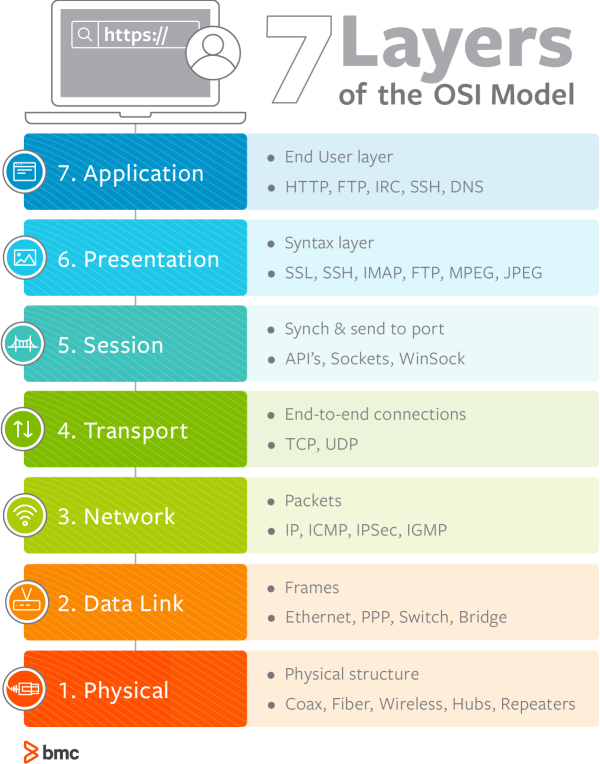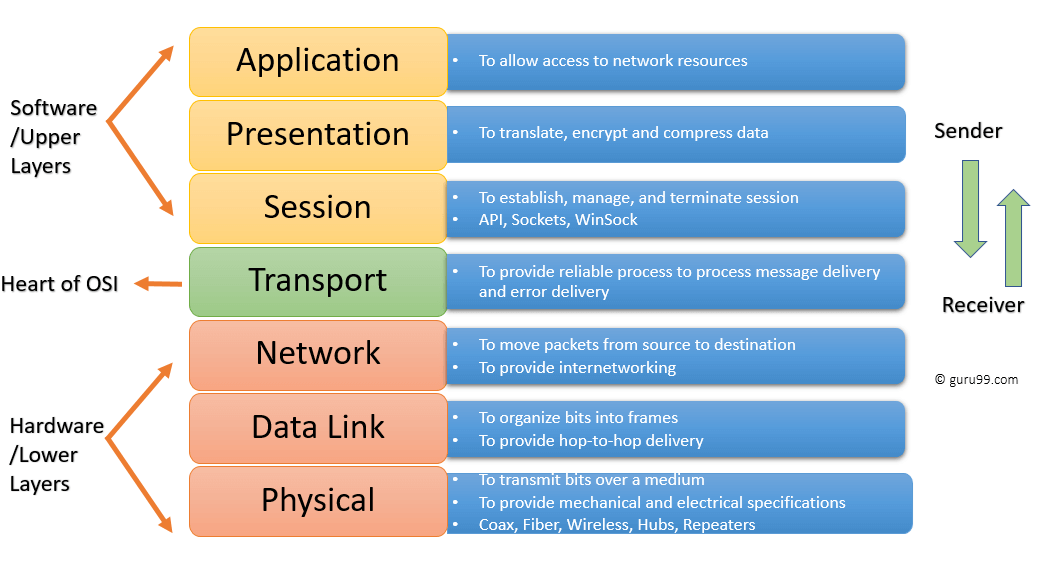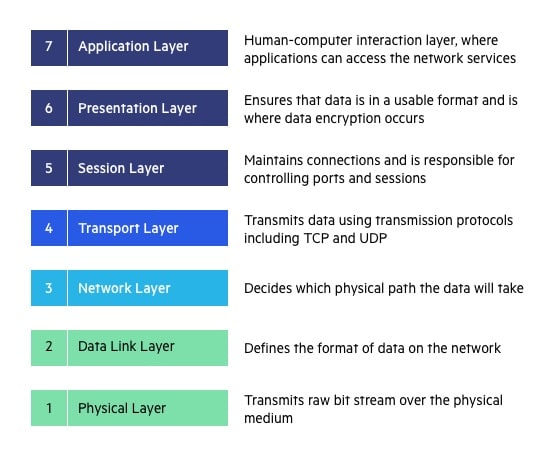Explain Different Types of Osi Layers
What does end to end mean. They deal with the physical aspect of moving data from one device to another.

The Osi Model Explained And How To Easily Remember Its 7 Layers
This is a bit like a preparation area before the real work begins.

. 2 Layer 2 Data-link Layer. The seven layers of the OSI Model are a physical layer data link layer network layer transport layer session layer presentation layer and application layer as shown in the following diagram. In the OSI model the user is the transport layer.
7 rows OSI model use two separate layers physical and data link to define the functionality of the. Instead of just node-to-node communication. The third layer is the OSI model.
The physical layer is responsible for the physical cable or wireless connection between network nodes. The main functionality of the physical layer is to transmit the individual bits from one node to another node. The OSI model was introduced in 1984.
The Data Link Layer is the second layer of the OSI model. MAC Media Access Control This sub-layer defines how the data packets are placed in media. Physical Layer At Layer 1 the Physical layer in the OSI model is responsible for the ultimate transmission of digital data bits from the Physical layer of the sending source device over network.
It is responsible for. 3 Layer 3 Network Layer. There are the seven OSI layers.
5 Layer 5 Session Layer. In the OSI reference model the communications between a computing system are split into seven different abstraction layers. Physical Data Link Network.
This layer has two sub-layers. OSI model is also called ISO OSI Reference Model. Which tells us how how applications communicate over a network.
It does the routing of packets received from the upper layer. Here is the functions of seven layers of OSI Reference Model. The standard model is necessary to ensure that worldwide data communication systems are developed in a way that they are compatible with each other.
Layers 56 and 7 can be are thought of as the user support. Devices like repeater hub cables ethernet work on this layer. The OSI 7 Layers 1.
The lower layers of the OSI model implement more primitive hardware-oriented functions like routing addressing and flow control. OSI uses the network layer to define the routing standards and protocols while TCPIP uses. As we mentioned previously the OSI model is divided into 7 different layers and here we are explaining these 7 layers of OSI model.
The lowest layer of the OSI reference model is the physical layer. The data link layer is responsible for the node-to-node delivery of the message. Protocols like RS232 ATM FDDI Ethernet work on this layer.
This layer defines how networking components access the media and what transmission methods they use. OSI uses three layers -- application presentation and session -- to define the functionality of upper layers while TCPIP uses only the application layer. This layer combines the OSI models L1 and L2.
It has seven interconnected layers. Presentation Two devices prepare to connect. The seven layers can be thought of as belonging to three subgroups.
A list of seven layers are given below. The upper layer is the user of the Network Layer. Layer 1 Network Access.
There are seven layers in OSI Model. The routing is end to end. 1 Layer 1 Physical layer.
Also called the Host-to-Host layer. Layers 12 and 3- physical data link and network are the network support layers. Also called the Process layer this layer combines the OSI.
4 Layer 4 Transport Layer. Network Layer Layer 3. Encryption and decryption tasks happen here.
The upper layers of the OSI model represent software that implements network services like encryption and connection management. This layer is similar to the OSI models L3. Physical Layer Layer 1.
Functions of Seven Layers of OSI Reference Model Physical Layer. The Data Link Layer allows nodes to communicate with each other within a local area network. Hardware layer of the OSI layer.
It has 7 different layers they are as follows-1physical layer. OSIOpen source interconnectivity is an reference model. OSI Model Explained.
The data link layer establishes and terminates a connection between two physically-connected nodes. This model tries to explain how the data of an application passes through the device and out in the physical network using the seven conceptual steps or layers. Data Link Layer DLL Layer 2.
This layer is similar to the OSI models L4. OSI uses two separate layers -- physical and data-link -- to define the functionality of the bottom layers while TCPIP uses only the link layer. This means the source to the destination IP layer.
It also provides physical addressing. Layer they allow interoperability among unrelated sw system. Each layer has different functions.
OSI model likes as universal language in computer networking system and it is totally depend on their abstract layers such as Physical Data Link Network Transport Session Presentation and Application. The physical layer data link layer and the network layer are the network support layers. Beginners here is a trick for you to remember all 7 layers of the OSI model in networking.
7 Layers Of The OSI Model. This is where we send information between and across networks through the use of routers. Every layer is allotted for specific task and every layer is self contained so that each layer in OSI model is capable to perform their functions independently.
The OSI model is a model that allows us to categorize network communications and divide different activities of the network in seven conceptual layers. It is the lowest layer of the OSI. A user works directly with some type of software such as a web browser.
Also called the Link or Network Interface layer. Layers of OSI Model 1. Layer 3 is the network layer.
Application Humancomputer interactions happen here. The foundations of line discipline flow control and error control are established in this layer.

Osi Model The 7 Layers Of Network Architecture Bmc Software Blogs


No comments for "Explain Different Types of Osi Layers"
Post a Comment